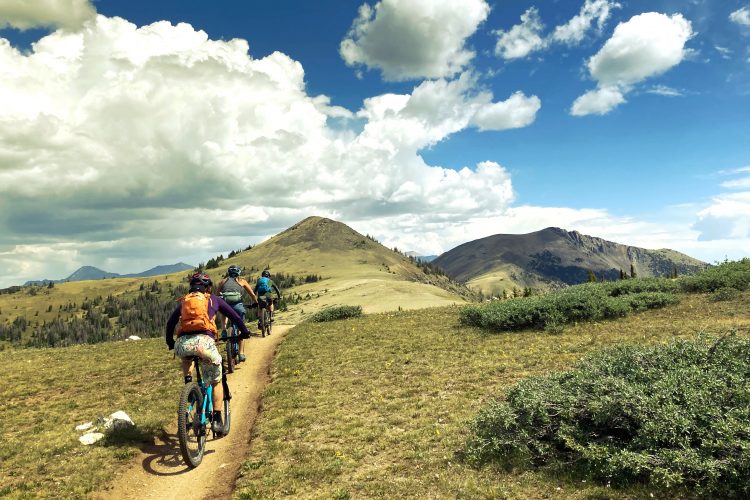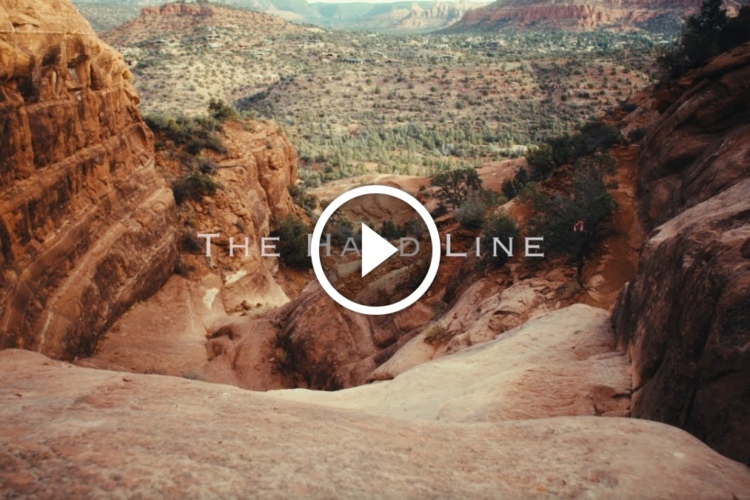
On a sunny morning in Southwest Utah, myself and photographer Hannah Morvay pummel down a dusty road toward the Little Creek trail system.
Little Creek is almost directly south of the acclaimed Gooseberry Mesa trail system, but doesn’t see nearly as many visitors. Part of that may be due to the fact that it is sparsely marked. There are sections of singletrack, but they only connect you to parts of undulating slick rock on the mesa, so it’s easy to get lost, and that happens. The other part is that after many, many years, it’s still not an entirely sanctioned trail.
The locals that we’ve talked to since arriving a few days prior have all recommended Little Creek, on the condition that you go with someone who knows the area. If you have a guide, then you’ll find yourself on a giant playground for mountain bikes, with drops, and jumps, and brazen little rock lines all over the place. If you don’t have a guide, then there’s a good chance you’ll get lost.
Lucky for us, it’s a Saturday and there is a group ride hosted by Over the Edge Hurricane, one of the more popular shops in Washington County. They typically host a ride somewhere every Saturday. It’s a diverse spectrum of riders and skill, with several stops and sessions on the rock features.

Somehow after only ten miles and 700 feet of climbing, we are all pretty cooked. The trail is physical to say the least, even for a moderate grade, and with a ton of traction, it takes a lot of work to get up and over steep features. Going downhill on the rock isn’t any more forgiving.
Sure, the layout of the trail could be easier, but it might not be as fun. Morgan Harris, also known as the “Godfather” played a large part in developing the Little Creek trail network. His style of building prioritizes fun over getting somewhere efficiently.
“When I build a trail, I look for features that are cool,” he tells us over a beer one night during our visit. “So, my trail may cover a lot of ground, but not go anywhere.”
Harris is in his 70s now, and still rides and digs often. His work has been skeletal for Washington County’s trails and laid the foundation for a greater mountain bike scene. Gooseberry Mesa, Little Creek, Church Rocks, J.E.M., and Guacamole all have Harris’ sweat spread throughout their dirt.
Before the Hurricane trails were the destination that they are now, Harris was building, because mountain biking wasn’t considered by the BLM. “It was easier to get forgiveness than it was to get permission,” he says.
Not so long ago, most of the trails weren’t considered mountain bike trails. They were hiking or cattle trails, and were ridden by mountain bikers. Or mountain bikers built their own trails. The BLM wasn’t all that concerned with them until the area gained more popularity. In 2010, the St. George BLM office began revising their travel plan, and that’s when local mountain bikers thought it would be a good idea to get organized, since the outcome could have affected all mountain bike trails in Washington County. That’s how the Dixie Mountain Bike Trails Association (DMBTA) formed.
In 2011, DMBTA started working with the BLM formally by having quarterly meetings and proposing trail projects. Kevin Christopherson joined DMBTA as a board member shortly after they formed. He says it wasn’t all that complicated or unreasonable to start approaching the BLM, it was just a matter of etiquette.
Asking rather than demanding, treating them with respect, and taking a batch of cookies into the district office every now and then greased the gears.

“We have this attitude that the government exists to serve us and if we’re not getting exactly what we want, we should just bitch about it. If you stop and think about it, they’re just people. If you treat them with respect and build relationships and partner with them instead of demanding things, you get stuff done.”
Christopherson has been the DMBTA president for about a year-and-a-half now. As a retired wildlife biologist, his qualifications and experience made it an easy conversation starter and a way to make it easier for the BLM to work with them. Christopherson offered to do the environmental assessments for trail feasibility himself on two different occasions, saving the BLM tens of thousands of dollars. The end result seemed worth it, and DMBTA was already handling the brunt of the work anyway.
As a 100% volunteer organization, no one at DMBTA is paid. Not the president, not the treasurer, not the builders, because, again, they are all volunteers. Toni Bain, DMBTA’s treasurer, estimates that about 90% of the trails are maintained by volunteers, with about 50 volunteers producing 500 hours of work in 2019.
DMBTA only has around 50 official members, each of which contributes about $38 a year. (The club membership costs $50 per year, and IMBA takes a $12 cut.) Christopherson estimates that the average cost to build a trail for them is about $5,000-10,000 per mile.

Grants are far more lucrative, but can also be competitive with multiple organizations going after a single grant. The state of Utah has a large fund available for grants though, so at least there’s money out there. When DMBTA wants to pursue one, they usually co-sign the application with the BLM and the BLM receives the money to build a trail, which is then contracted out to a builder, and the DMBTA serves as a project advisor. DBMTA’s volunteer efforts again save the BLM money during the initial phases, since the volunteers handle survey work and flag the trail before the environmental analysis takes place.
Most of the time though, it’s easier to get a new trail built, rather than getting an old trail fixed, and that’s not to say that it’s easy getting a new trail.
“With the grant program it’s almost easier to just jump through the hoops and hire a crew and then supplement with volunteers,” says Christopherson. Volunteers show up in the tens when a new trail is announced. On a maintenance day, they’re more likely to get a small handful of helpers.
Up until the Trump administration took office, the BLM had more money to help maintain the district’s trails and were much more active in trail maintenance, says DMBTA. The Trump Administration cut $163M from the BLM’s budget going into the 2018 fiscal year, prioritizing energy security and reducing their focus on recreation. “The BLM was definitely more active before the money was lost,” says Christopherson.
Still the greater Zion area has seen a healthy gain in trails in the past several years. The number of trails has multiplied in St. George, Hurricane, Kanab, and Cedar City.
Cedar City, less than an hour north of St. George has been leading the trail building charge lately with quite a few grants from the city’s tourism department, and has hired IMBA’s acclaimed, yet costly Trail Solutions team to add to the growing networks. “You have to have a lot of money,” says Christopherson. “If you do, they do an awesome job.”
The Cedar City sub-chapter is one of four under DMBTA. The counties together cover all of Southwest Utah and make a distinct quadrant in the corner of the state, and sometimes beyond. DMBTA also added the newest extension onto the Rainbow Rim trail in Arizona, which rides along the rim of the Grand Canyon.
Considering the growth and mountain bike traffic that Southwest Utah has experienced, and the meager volunteer force and funding, DMBTA is used to doing more with less, but that doesn’t make it any easier.
“Geographically, it’s more than we can handle,” says Christopherson. Eventually, this may prompt a change in how DMBTA is run. The problem isn’t that nobody wants to help, but membership and inconsistent grants and donations aren’t enough at this point to maintain and grow the trails in the area, and keep pace with increased visitation.
Red Bull has been a great partner to DMBTA. Every year, when thousands of spectators visit to watch Rampage, the energy drink giant donates $5 per ticket to DMBTA. The large amount of cash that ends up being about five figures every year helped create the Cedar City trails. Every now and then, someone using the Trailforks app will give money to DMBTA via a ‘donate’ button. In 2019 someone sent $500 with the app. It’s more likely that someone will send $50 or $100.
Christopherson says that when he wears his DMBTA shirt around town, someone will occasionally walk up to him and hand him a twenty dollar bill as a donation, but they’re usually not interested in an ongoing membership.
“It is a conundrum. It’s almost impossible to fund a non-profit with membership, and that’s something a lot of people don’t understand, even for really powerful ones like the NRA. Think about spending $10,000 a mile, how many members would you need at $30 a year to build a trail?”
The reality of the situation seems at odds in a way. Tourism is booming, with help from the tourism department of course. With media coverage, events like the Hurricane Bike Festival and Red Bull Rampage, and year-round riding on countless mountain bike optimized trails, the word is out that St. George and the surrounding areas are well worth visiting.
When we sat with Toni Bain and Morgan Harris for beers, both of them said that DMBTA needs to catch up on trail maintenance before the area gains more popularity. I was surprised, because it’s not often that you hear from a mountain bike organization that they don’t want more people on their trails. More people visiting equals more money injected in the local economy, but it also equals more ruts and beat up trails. Christopherson says that Washington County estimated that the economic impact from mountain biking was $26M based on trail count data, a report he’s spent time analyzing. The BLM estimated about $21M.

Christopherson would like to add a paid trail crew, like a few other destinations in Utah have. Maintaining the hundreds of miles of trail in Washington County just isn’t possible with volunteers. There is still a need for more trails to ease traffic and impact, and the right type of trails to satisfy a newer generation of riders. And there is still no easy answer.
“We have to pick and choose what we have time for. We’re at the point where we have to decide whether we want to get into fundraising in a very big way and hire an executive secretary, or do we want to have a paid person on staff because it’s getting too big, or do we scale back and focus on being involved here?”
By no means is this conundrum grim for the DMBTA, the volunteers, the board members, the city, or the countless visitors who ride the trails year round. Visit any trailhead and you’ll see plenty of mountain bikers returning to their cars with a smile on their faces. Ride the trails and you’ll have a smile on yours. But, also consider what shape you’d like the trails to be in the next time you ride them. Passionate locals like Morgan Harris might have been the “trail fairies” in the early days of St. George mountain biking, but there’s far too much trail to shake a wand at now.
Thanks to Greater Zion Tourism for helping support this trip.
























1 Comments
Jan 30, 2020